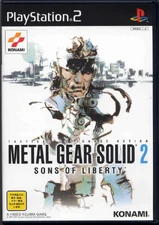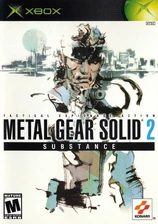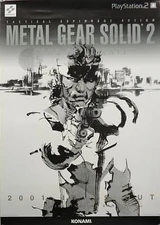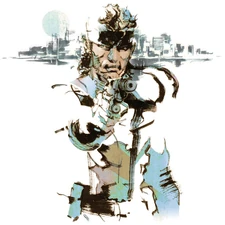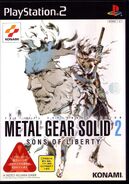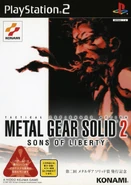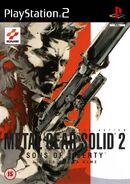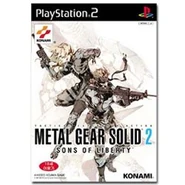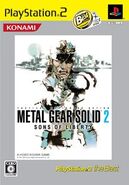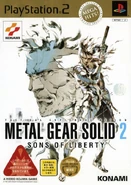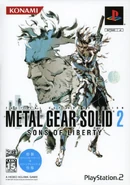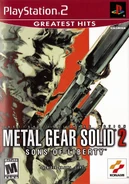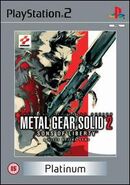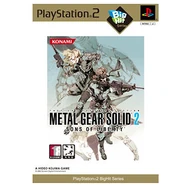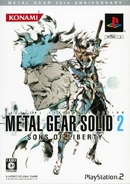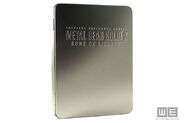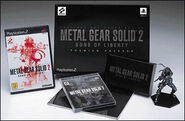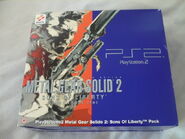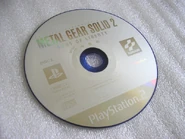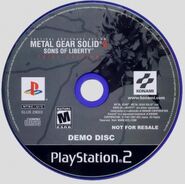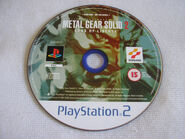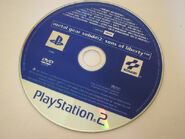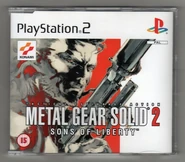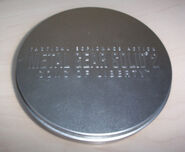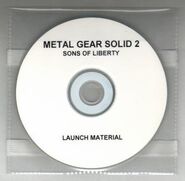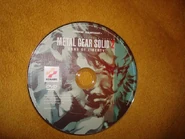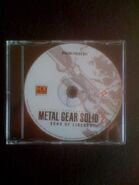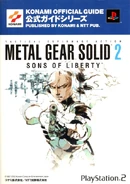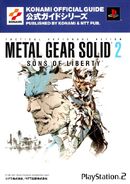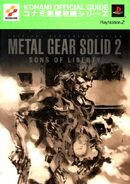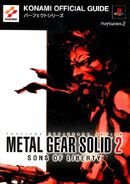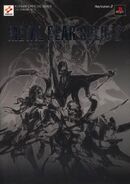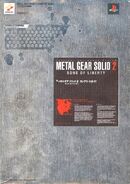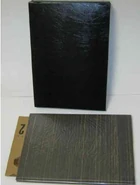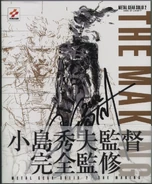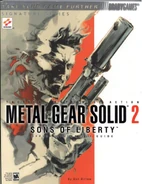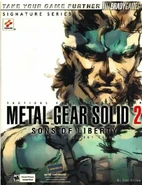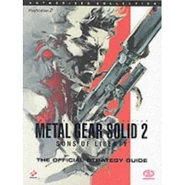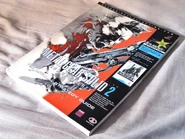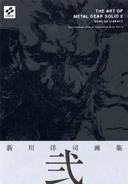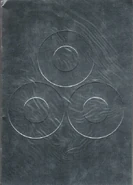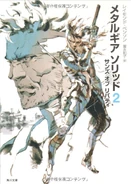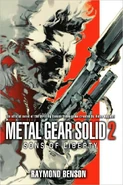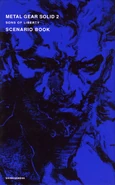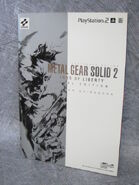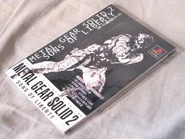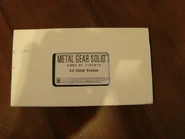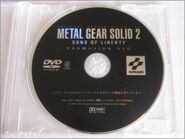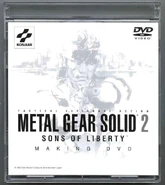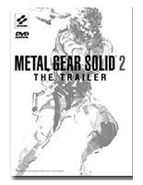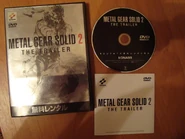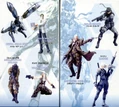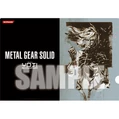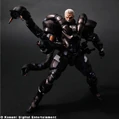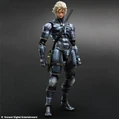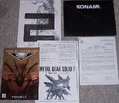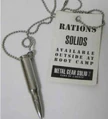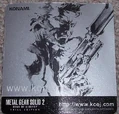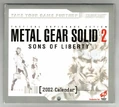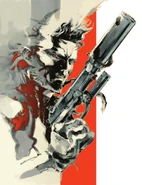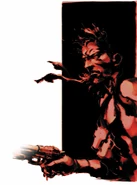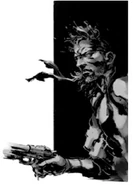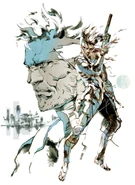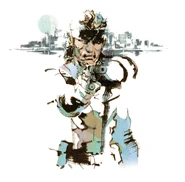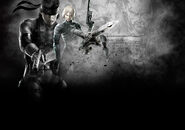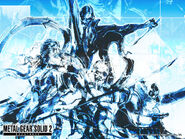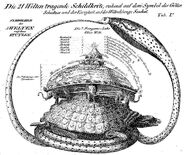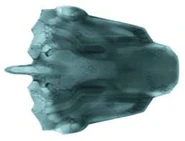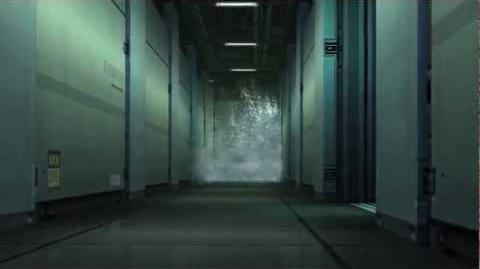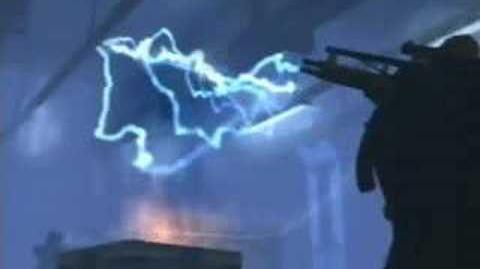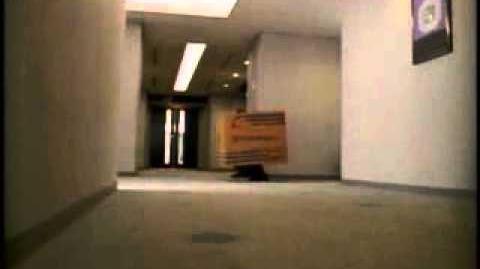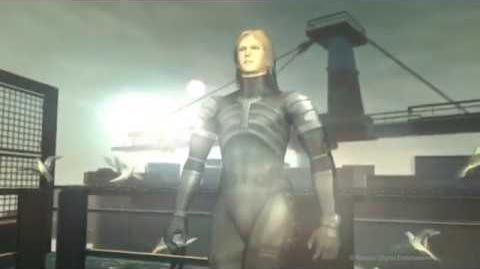(Undid revision 238794 by Weedle McHairybug (Talk)) Tag: sourceedit |
(→Plot) Tag: Visual edit |
||
| (44 intermediate revisions by 10 users not shown) | |||
| Line 1: | Line 1: | ||
| − | {{DISPLAYTITLE:''Metal Gear Solid 2: Sons of Liberty''}} |
+ | {{DISPLAYTITLE:''Metal Gear Solid 2: Sons of Liberty''}}{{Youmay|the video game, ''Metal Gear Solid 2: Sons of Liberty''|the [[Sons of Liberty (terrorist group)|titular organization]]}} |
| − | {{Youmay|the video game, ''Metal Gear Solid 2: Sons of Liberty''|the [[Sons of Liberty (terrorist group)|titular organization]]}} |
||
{{Game Infobox |
{{Game Infobox |
||
| ⚫ | |||
|image = Mgs2sol.jpg |
|image = Mgs2sol.jpg |
||
| − | |developer = [[Konami|Konami Computer Entertainment Japan (West)]] |
+ | |developer = [[Konami Computer Entertainment Japan|Konami Computer Entertainment Japan (West)]] |
|publisher = [[Konami]] |
|publisher = [[Konami]] |
||
|designer = [[Hideo Kojima]] <small>([[wikipedia:Video game director|director]], [[wikipedia:Video game producer|producer]])</small><br />[[Tomokazu Fukushima]] <small>(game design credits are omitted in the game)</small> |
|designer = [[Hideo Kojima]] <small>([[wikipedia:Video game director|director]], [[wikipedia:Video game producer|producer]])</small><br />[[Tomokazu Fukushima]] <small>(game design credits are omitted in the game)</small> |
||
| Line 10: | Line 8: | ||
|artist = [[Yoji Shinkawa]] |
|artist = [[Yoji Shinkawa]] |
||
|composer = [[Harry Gregson-Williams]]<br />[[Norihiko Hibino]]<br />[[Rika Muranaka]] |
|composer = [[Harry Gregson-Williams]]<br />[[Norihiko Hibino]]<br />[[Rika Muranaka]] |
||
| − | |released = {{vgrelease|NA=November 12, 2001}}{{vgrelease|JP=November 29, 2001|EU=March 8, 2002}} |
+ | |released = '''PlayStation 2:'''<br />{{vgrelease|NA=November 12, 2001}}{{vgrelease|JP=November 29, 2001|EU=March 8, 2002}}'''Nvidia Shield:'''<br />{{vgrelease|INT=August 22, 2017}} |
|genre = [[Wikipedia:Stealth game|Stealth]] [[wikipedia:Action game|action]] |
|genre = [[Wikipedia:Stealth game|Stealth]] [[wikipedia:Action game|action]] |
||
|modes = [[Wikipedia:Single-player video game|Single-player]] |
|modes = [[Wikipedia:Single-player video game|Single-player]] |
||
|ratings = {{vgratings|ESRB=M|CERO=15+|BBFC=15|OFLCA=MA15+|OFLCNZ=R16|USK=16|PEGI=16}} |
|ratings = {{vgratings|ESRB=M|CERO=15+|BBFC=15|OFLCA=MA15+|OFLCNZ=R16|USK=16|PEGI=16}} |
||
| − | |platforms = [[PlayStation 2]] |
+ | |platforms = [[PlayStation 2]], Nvidia Shield |
|media = 1 [[Wikipedia:DVD|DVD]] |
|media = 1 [[Wikipedia:DVD|DVD]] |
||
|input = [[wikipedia:Gamepad|Gamepad]] |
|input = [[wikipedia:Gamepad|Gamepad]] |
||
| − | |pregame = ''[[Metal Gear |
+ | |pregame = ''[[Metal Gear: Ghost Babel]]'' <br />(2000) |
| − | | |
+ | |thisgame = ''[[Metal Gear Solid 2: Sons of Liberty]]'' <br />(2001) |
| − | | |
+ | |nxtgame = ''[[The Document of Metal Gear Solid 2]]'' <br />(2002) |
| − | |nxtcanongame = ''[[Metal Gear Solid 4: Guns of the Patriots]]'' |
||
}} |
}} |
||
| − | {{nihongo|'''''Metal Gear Solid 2: Sons of Liberty'''''|メタルギアソリッド2 サンズ・オブ・リバティ|Metaru Gia Soriddo 2 Sanzu Obu Ribati|commonly abbreviated as '''''MGS2'''''}} is a stealth action game directed by [[Hideo Kojima]], developed by [[ |
+ | {{nihongo|'''''Metal Gear Solid 2: Sons of Liberty'''''|メタルギアソリッド2 サンズ・オブ・リバティ|Metaru Gia Soriddo 2 Sanzu Obu Ribati|commonly abbreviated as '''''MGS2'''''}} is a stealth action game directed by [[Hideo Kojima]], developed by [[Konami Computer Entertainment Japan]] and published by Konami for the [[PlayStation 2]] in 2001. It is the fourth game in the {{Metal Gear series}} produced and directed by Kojima and is the direct sequel of ''[[Metal Gear Solid]]''. Its release was followed by an expanded edition, ''[[Metal Gear Solid 2: Substance]]'' for the PlayStation 2, [[wikipedia:Xbox|Xbox]], and [[wikipedia:Microsoft Windows|Microsoft Windows]]. ''[[Metal Gear Solid 3: Snake Eater]]'', a prequel to the entire ''Metal Gear'' series, followed in 2004. In 2008, a direct sequel, ''[[Metal Gear Solid 4: Guns of the Patriots]]'' was released. |
| − | The game was well-received, shipping over 7 million copies worldwide. It received a metascore of 96 on Metacritic and average of 95.09% on GameRankings.<ref name="Metacritic">[http://www.metacritic.com/game/playstation-2/metal-gear-solid-2-sons-of-liberty Metal Gear Solid 2: Sons of Liberty for PlayStation 2 Reviews - Metacritic]</ref><ref name="GameRankings">[http://www.gamerankings.com/ps2/913941-metal-gear-solid-2-sons-of-liberty/index.html Metal Gear Solid 2: Sons of Liberty for PlayStation 2 - GameRankings]</ref> While the gameplay and graphics were universally acclaimed, critics and fans were divided on the philosophical nature and execution of the game's storyline, which explores the themes of memes, social engineering, political conspiracies, and artificial intelligence. Critics and fans were also divided on [[Raiden]], a new character who serves as the main protagonist for the majority of the game and the length of the game's cutscenes. Over the years, the game has seen greater acclaim. |
+ | The game was well-received, shipping over 7 million copies worldwide. It received a metascore of 96 on Metacritic and average of 95.09% on GameRankings.<ref name="Metacritic">[http://www.metacritic.com/game/playstation-2/metal-gear-solid-2-sons-of-liberty Metal Gear Solid 2: Sons of Liberty for PlayStation 2 Reviews - Metacritic]</ref><ref name="GameRankings">[http://www.gamerankings.com/ps2/913941-metal-gear-solid-2-sons-of-liberty/index.html Metal Gear Solid 2: Sons of Liberty for PlayStation 2 - GameRankings]</ref> While the gameplay and graphics were universally acclaimed, critics and fans were divided on the philosophical nature and execution of the game's storyline, which explores the themes of memes, social engineering, political conspiracies, and artificial intelligence. Critics and fans were also divided on [[Raiden]], a new character who serves as the main protagonist for the majority of the game and the length of the game's cutscenes. Over the years, the game has seen greater acclaim. |
== Plot == |
== Plot == |
||
{{Mgs order}} |
{{Mgs order}} |
||
| − | Two years after the events of [[Shadow Moses Incident]], [[Solid Snake]] and [[Hal Emmerich|Otacon]], working as [[Philanthropy]], receive intelligence of a new type of [[Metal Gear RAY (manned)|Metal Gear]] being transported through the Hudson River. As Snake boards the tanker, it's seized by a group of [[Gurlukovich Mercenaries|Russian mercenaries]] led by [[Revolver Ocelot]], intent on stealing the new Metal Gear. |
+ | Two years after the events of the [[Shadow Moses Incident]], [[Solid Snake]] and [[Hal Emmerich|Otacon]], working as [[Philanthropy]], receive intelligence of a new type of [[Metal Gear RAY (manned)|Metal Gear]] being transported through the Hudson River. As Snake boards the tanker, it's seized by a group of [[Gurlukovich Mercenaries|Russian mercenaries]] led by [[Revolver Ocelot]], intent on stealing the new Metal Gear. |
:''For a full summary of the Tanker Chapter, see [[Tanker Incident]].'' |
:''For a full summary of the Tanker Chapter, see [[Tanker Incident]].'' |
||
| Line 45: | Line 42: | ||
|[[Solid Snake]] |
|[[Solid Snake]] |
||
|[[David Hayter]] |
|[[David Hayter]] |
||
| − | |Akio Ōtsuka |
+ | |[[Akio Ōtsuka]] |
|Mizuho Yoshida |
|Mizuho Yoshida |
||
|- |
|- |
||
|[[Raiden]] |
|[[Raiden]] |
||
|[[Quinton Flynn]] |
|[[Quinton Flynn]] |
||
| − | |Kenyu Horiuchi |
+ | |[[Kenyu Horiuchi]] |
|Eiji Morisaki |
|Eiji Morisaki |
||
|- |
|- |
||
| Line 60: | Line 57: | ||
|[[Rosemary]] |
|[[Rosemary]] |
||
|[[Lara Cody]] |
|[[Lara Cody]] |
||
| − | |Kikuko Inoue |
+ | |[[Kikuko Inoue]] |
| |
| |
||
|- |
|- |
||
| Line 68: | Line 65: | ||
| |
| |
||
|- |
|- |
||
| − | |[[Colonel]] |
+ | |[[Colonel (AI)|Colonel]] |
|[[Paul Eiding]] |
|[[Paul Eiding]] |
||
|Takeshi Aono |
|Takeshi Aono |
||
| Line 85: | Line 82: | ||
|[[Vamp]] |
|[[Vamp]] |
||
|[[Phil LaMarr]] <small>(credited as Phil La Marr)</small> |
|[[Phil LaMarr]] <small>(credited as Phil La Marr)</small> |
||
| − | |Ryōtarō Okiayu |
+ | |[[Ryōtarō Okiayu]] |
| |
| |
||
|- |
|- |
||
| Line 120: | Line 117: | ||
|[[Scott Dolph]] |
|[[Scott Dolph]] |
||
|[[Kevin Michael Richardson]] <small>(credited as Kevin M. Richardson) </small> |
|[[Kevin Michael Richardson]] <small>(credited as Kevin M. Richardson) </small> |
||
| − | |Daisuke Gōri |
+ | |Daisuke Gōri |
| |
| |
||
|- |
|- |
||
| Line 170: | Line 167: | ||
== Theme == |
== Theme == |
||
| − | Memetic engineering (the theory that ideas, beliefs and thoughts can be isolated and controlled) is the theme of this game. The aim of [[the Patriots]] is to control the flow of information through society, censoring the public |
+ | Memetic engineering (the theory that ideas, beliefs and thoughts can be isolated and controlled) is the theme of this game. The aim of [[the Patriots]] is to control the flow of information through society, censoring what they deem to be "trivial" or "biased" information from the public. With the dawn of the digital age, information can be spread more openly and freely by individuals. But this also carries the risk that said Information is biased or outright incorrect. Thus allowing lies to become a part of human culture and slowing down the overall evolutionary progress of humanity. The Patriots' AIs have the ability to not be subjective on the information that they create because they're machines. The AIs can logically decide what the best or most reliable information is without letting personal opinions or mentions interfere with their conclusions. Therefore greatly eliminating bias by filtering information on the Internet and halting the process of lies that come with the digital age. |
| + | |||
| + | Solid Snake's philosophy is that humanity needs to find something worth believing in and pass it on to future generations. Over the course of the game, he teaches Raiden to question what he believes in and as a mentor like figure, encourages him to come to a new understanding about life and what information he wants to pass onto future generations. Through the way he influences Raiden, Solid Snake is representative of a hope that humanity can use the advantages of the digital age without allowing lies and falsehoods to corrupt people's outlook or culture. Snake has the wisdom to think for himself, dismiss what he sees as lies and has confidence on what he wants to pass onto future generations. |
||
Substance is also a theme within the game. Raiden is a blank character, as he has been controlled and used his entire life. When Rosemary tells him about his room, an all white room with nothing more than a bed and a desk, Raiden becomes angry. When he finally meets with Solidus Snake, the person who introduced Raiden into war, he ends up having his own substance and personality. After taking down his "father" so to speak, he proclaimed his love to Rose, although she herself is also part of the "meme" theme. Rose was initially sent by the Patriots to keep tabs on Raiden, but after a while, she legitimately fell in love with him. |
Substance is also a theme within the game. Raiden is a blank character, as he has been controlled and used his entire life. When Rosemary tells him about his room, an all white room with nothing more than a bed and a desk, Raiden becomes angry. When he finally meets with Solidus Snake, the person who introduced Raiden into war, he ends up having his own substance and personality. After taking down his "father" so to speak, he proclaimed his love to Rose, although she herself is also part of the "meme" theme. Rose was initially sent by the Patriots to keep tabs on Raiden, but after a while, she legitimately fell in love with him. |
||
| + | |||
| + | The game was also considered to be among the first games to push the philosophical concept of postmodernism as a theme.<ref>http://www.eurogamer.net/articles/2015-08-16-metal-gear-solid-2-the-first-postmodern-video-game</ref> Kojima, in an interview with ''Wired'', also explained that making a post-modern plotline for a game was one of his main goals for ''Metal Gear Solid 2''.<ref>http://archives.insertcredit.com/features/dreaming2/index5.html</ref> |
||
== Gameplay == |
== Gameplay == |
||
| − | ''Metal Gear Solid 2'' carries the title of "Tactical Espionage Action," and most of the game involves the protagonist sneaking around avoiding being seen by the enemies. The game also features many more elements than its predecessor. The new first person aiming mode allows the player to target specific points in the game, greatly expanding tactical options, while guards can be blinded by steam and distracted by thrown objects. The player can now walk slowly, allowing them to sneak over noisy flooring without making a sound, or hang off walkways to avoid guards. The corner-press move from the original title, which allowed the player a sneak peek around the next bend, is expanded to allow them to fire from cover.<ref>[http://www.absolute-playstation.com/metal_gear_2/metal_gear_2_feature_1.htm Metal Gear Solid 2 PS2 Game Guide]</ref> |
+ | ''Metal Gear Solid 2'' carries the title of "Tactical Espionage Action," and most of the game involves the protagonist sneaking around avoiding being seen by the enemies. The game also features many more elements than its predecessor. The new first person aiming mode allows the player to target specific points in the game, greatly expanding tactical options, while guards can be blinded by steam and distracted by thrown objects. The player can now walk slowly, allowing them to sneak over noisy flooring without making a sound, or hang off walkways to avoid guards. The corner-press move from the original title, which allowed the player a sneak peek around the next bend, is expanded to allow them to fire from cover.<ref>[http://www.absolute-playstation.com/metal_gear_2/metal_gear_2_feature_1.htm Metal Gear Solid 2 PS2 Game Guide]</ref> |
The guards were given more advanced AI "to prevent an imbalance of power," and unlike the original ''Metal Gear Solid'', work in squads. They will call on their radios for a strike team upon seeing the player, then attempt to flank them and cut off their escape while avoiding the player's attacks. If the player is skilled enough, the guards radio can be disabled with a well-placed shot with any firearm. Often strike teams will carry body armor and riot shields, making them an even greater threat. The player can hide from guards and strike teams by hiding in places such as lockers or bathroom stalls.<ref name="Answers.com">http://www.answers.com/topic/metal-gear-solid-2-sons-of-liberty</ref> |
The guards were given more advanced AI "to prevent an imbalance of power," and unlike the original ''Metal Gear Solid'', work in squads. They will call on their radios for a strike team upon seeing the player, then attempt to flank them and cut off their escape while avoiding the player's attacks. If the player is skilled enough, the guards radio can be disabled with a well-placed shot with any firearm. Often strike teams will carry body armor and riot shields, making them an even greater threat. The player can hide from guards and strike teams by hiding in places such as lockers or bathroom stalls.<ref name="Answers.com">http://www.answers.com/topic/metal-gear-solid-2-sons-of-liberty</ref> |
||
| Line 184: | Line 185: | ||
== Development == |
== Development == |
||
| − | ''Metal Gear Solid 2'' began development in 1999. It was originally going to titled ''Metal Gear Solid III''. The Roman numerals in the title was used to represent the three tallest skyscrapers in Manhattan, the setting of the game.<ref name="Game Plan"/> |
+ | ''Metal Gear Solid 2'' began development in 1999. It was originally going to titled ''Metal Gear Solid III''. The Roman numerals in the title was used to represent the three tallest skyscrapers in Manhattan, the setting of the game.<ref name="Game Plan"/> In addition, Hideo Kojima implied that several of the themes he intended to be used in ''Metal Gear Solid 2'' were essentially put into film format by the Wachowskis via their movie ''The Matrix'' beforehand.<ref>https://web.archive.org/web/20130328062143/http://www.gamespot.com/news/hideo-kojima-speaks-about-the-matrix-2448486<br />''Kojima made a very interesting comment: "I have seen the movie four times (laughs). I like this type of work. What I was planning to do in my next project, they pretty much made into a motion picture. We were planning on certain things like characters running on walls and such, but they've beat me to it (laughs)."''</ref> |
According to Hideo Kojima in the documentary ''[[Metal Gear Saga#Volume 1|Metal Gear Saga Vol. 1]]'', the original plot of the game revolved around nuclear weapon inspections in Iraq and Iran. In the plot, Solid Snake was supposed to stop the new[[File:Metal Gear Solid 2 Making of The Hollywood Game|thumb|right|335 px]] Metal Gear while it was located on an aircraft carrier, in a certain time limit. He was also supposed to defeat [[Liquid Snake]] and his group, implying that Liquid had faked his death from [[FOXDIE]] in the previous game. However, about six months into the project, tensions in the Middle East began to arise, so the development team decided that they couldn't make a game with such a plot. The tanker in the final version is based on the original plot.<ref>[http://www.youtube.com/watch?v=gIRDmYIae4Y Metal Gear Saga Vol. 1 - YouTube]</ref> |
According to Hideo Kojima in the documentary ''[[Metal Gear Saga#Volume 1|Metal Gear Saga Vol. 1]]'', the original plot of the game revolved around nuclear weapon inspections in Iraq and Iran. In the plot, Solid Snake was supposed to stop the new[[File:Metal Gear Solid 2 Making of The Hollywood Game|thumb|right|335 px]] Metal Gear while it was located on an aircraft carrier, in a certain time limit. He was also supposed to defeat [[Liquid Snake]] and his group, implying that Liquid had faked his death from [[FOXDIE]] in the previous game. However, about six months into the project, tensions in the Middle East began to arise, so the development team decided that they couldn't make a game with such a plot. The tanker in the final version is based on the original plot.<ref>[http://www.youtube.com/watch?v=gIRDmYIae4Y Metal Gear Saga Vol. 1 - YouTube]</ref> |
||
[[File:MGS2 Trial Edition - Title Screen.png|thumb|200px|Title screen of ''Metal Gear Solid 2: Sons of Liberty Trial Edition''.]] |
[[File:MGS2 Trial Edition - Title Screen.png|thumb|200px|Title screen of ''Metal Gear Solid 2: Sons of Liberty Trial Edition''.]] |
||
| ⚫ | ''Metal Gear Solid 2'' was also intended to reference the novel ''City of Glass'', a novel by Paul Auster published in 1985, most notably in the naming of its characters. Raiden's support team originally featured a field commander named Daniel Quinn (simply referred as the "Colonel" in-game); Maxine "Max" Work, an Asian woman who saves the game data and quotes Shakespeare; and William "Doc" Wilson, the creator of [[GW]]. All take their names from key characters in the book, and all three would have turned out to be AIs. None of these characters appear in the final version. Their roles were absorbed by other characters, namely the "[[Colonel (AI)|Colonel Campbell]]" simulation, Rose, and [[Emma Emmerich]]. [[Peter Stillman]], however, takes his name from another ''City of Glass'' character.<ref name="Game Plan">''Metal Gear Solid 2 Grand Game Plan''.</ref> |
||
| ⚫ | |||
| − | |||
| − | {{Quote|Since the story resembled 911 closely, and some people said ‘Raiden’ reminds them of ‘Bin Laden.’|Hideo Kojima}} |
||
| − | |||
| ⚫ | The name was altered because in Japanese, "Laden" is written as ラーディン.<ref>Kotaku. [http://www.kotaku.com.au/2011/09/what-osama-bin-laden-and-metal-gears-solid-have-in-common/ ''What Osama Bin Laden And Metal Gears Solid Have In Common'']. [http://www.kotaku.com.au/ Kotaku]. Retrieved 2011-09-29.</ref> |
||
| − | |||
| ⚫ | ''Metal Gear Solid 2'' was also intended to reference the novel ''City of Glass'', a novel by Paul Auster published in 1985, most notably in the naming of its characters. Raiden's support team originally featured a field commander named Daniel Quinn (simply referred as the "Colonel" in-game); Maxine "Max" Work, an Asian woman who saves the game data and quotes Shakespeare; and William "Doc" Wilson, the creator of [[GW]]. All take their names from key characters in the book, and all three would have turned out to be AIs. None of these characters appear in the final version. Their roles were absorbed by other characters, namely the "[[Colonel|Colonel Campbell]]" simulation, Rose, and [[Emma Emmerich]]. [[Peter Stillman]], however, takes his name from another ''City of Glass'' character.<ref name="Game Plan">''Metal Gear Solid 2 Grand Game Plan''.</ref> |
||
A two player versus mode was also planned. However, it was dropped for unknown reasons.<ref name="Game Plan"/> |
A two player versus mode was also planned. However, it was dropped for unknown reasons.<ref name="Game Plan"/> |
||
| − | ''Metal Gear Solid 2'' is the first ''Metal Gear'' game to contain a note at the beginning that states that the events of the story are fictional.<ref>''Metal Gear Solid 2: Sons of Liberty'', Konami Computer Entertainment Japan (2001). <br>''After the player selects the chapter they want to play, the message "This story is fictional. Any and all similarities to characters, groups, or other entities in real life are coincidental" will pop up.''</ref> This would later be repeated in ''[[Metal Gear Solid V: The Phantom Pain]]'' |
+ | ''Metal Gear Solid 2'' is the first ''Metal Gear'' game to contain a note at the beginning that states that the events of the story are fictional.<ref>''Metal Gear Solid 2: Sons of Liberty'', Konami Computer Entertainment Japan (2001). <br>''After the player selects the chapter they want to play, the message "This story is fictional. Any and all similarities to characters, groups, or other entities in real life are coincidental" will pop up.''</ref> The note was presumably added in due to the events of September 11. This would later be repeated in ''[[Metal Gear Solid V: The Phantom Pain]]''. |
The consistent plot device throughout the game of all the characters either giving lies at least once or otherwise betraying and going to the other side of the conflict, according to Kojima, was based on the film ''[[wikipedia:L.A. Confidential (film)|L.A. Confidential]]''.<ref>[http://web.archive.org/web/20130709185620/http://muni_shinobu.webs.com/mgs2/production.html MGS2 Production Background Notes]</ref> |
The consistent plot device throughout the game of all the characters either giving lies at least once or otherwise betraying and going to the other side of the conflict, according to Kojima, was based on the film ''[[wikipedia:L.A. Confidential (film)|L.A. Confidential]]''.<ref>[http://web.archive.org/web/20130709185620/http://muni_shinobu.webs.com/mgs2/production.html MGS2 Production Background Notes]</ref> |
||
| + | |||
| + | According to the localizer of the game, Agness Kaku, Konami and Kojima had been insistent that the localized script remain exactly the same as in Japan on a micro-level in a manner comparable to scientific journals and legal documents, meaning she could not remove anything even to keep the flow or reduce repetition.<ref>http://www.eatchain.com/garbage/METALGEAR%3F%3F%3F/Metal%20Gear%20Solid%202%20Agness%20Kaku%20Intereview/Page%202/Hardcore%20Gaming%20101%20%20Agness%20Kaku%20Interview.htm</ref> |
||
===Footage=== |
===Footage=== |
||
Just like in the previous game, real life footage was utilized for the game, namely for the New York City aspects. Some of the footage was done first-hand by the Konami development team, while others were supplied via IMAGICA Corp., FRONT LINE, Inc., and ABCNEWS VIDEOSOURCE. |
Just like in the previous game, real life footage was utilized for the game, namely for the New York City aspects. Some of the footage was done first-hand by the Konami development team, while others were supplied via IMAGICA Corp., FRONT LINE, Inc., and ABCNEWS VIDEOSOURCE. |
||
| + | |||
| + | ===September 11 terror attacks=== |
||
| + | <gallery type="slideshow"> |
||
| + | DmvqwNlX4AMwBWc.jpg|''Electronic Gaming Monthly'' cover for ''Metal Gear Solid 2''. |
||
| + | Dmvrb5VXcAA2dV0.jpg|Japanese cover for ''Metal Gear Solid 2: Sons of Liberty''. |
||
| + | DmvreQkXsAUNhmi.jpg|Xbox cover for ''Metal Gear Solid 2: Substance''. |
||
| + | Dmw7T_LU4AAEJm0.jpg|Japanese promotional poster for ''Metal Gear Solid 2''. |
||
| + | DmvvH35VAAAmznH.jpg|Edited artwork (note that the Japanese cover, the Japanese promotional poster, and the cover for the Xbox version of ''Substance'' all had this version of the artwork, while ''EGM'' had the original). |
||
| + | </gallery> |
||
| ⚫ | Because the game finished development before 9/11 but wasn't due to be released yet, several aspects ended up significantly edited to avoid highlighting any similarities to the terror attacks. The most notable changes were a sequence depicting [[Arsenal Gear]]'s displacement of the Statue of Liberty and crashing through half of Manhattan was removed, as was a short coda that was supposed to appear after the credits, consisting of a newscast showing the Statue of Liberty's new resting place on Ellis Island. At the point where [[Solidus Snake]] dies, Raiden was to have cut the rope on Federal Hall's flagpole, causing an American flag to fall over Solidus' body, though the development team removed all the American flags from the game.<ref>''The Document of Metal Gear Solid 2''.</ref> |
||
| + | |||
| + | Additionally, several pieces of dialogue were cut, such as Liquid Ocelot claiming responsibility for Arsenal Gear ramming into Manhattan, as well as Vamp explicitly stating that Dead Cell's plan to use the purified hydrogen bomb to nuke Manhattan outright was independent of Solidus's goal of causing an EMP, and Raiden accusing President Johnson of working for the terrorists. |
||
| + | |||
| ⚫ | For most of the game's development, Raiden's name was written in katakana as ライデン or literally "Raiden." After 9/11, his name began to be written in kanji as 雷電. The name was altered because in Japanese, "Laden" is written as ラーディン.<ref>Kotaku. [http://www.kotaku.com.au/2011/09/what-osama-bin-laden-and-metal-gears-solid-have-in-common/ ''What Osama Bin Laden And Metal Gears Solid Have In Common'']. [http://www.kotaku.com.au/ Kotaku]. Retrieved 2011-09-29.</ref> |
||
| + | |||
| + | To a lesser extent, some artwork for the game was also altered as a result of 9/11. A notable example of this was one of the artworks that depicted Solid Snake posing near the Manhattan skyline. Originally, the skyline showed the World Trade Center, although this was edited out for the final versions of the artwork, including the version included in ''The Art of Metal Gear Solid 2''. The original can be found on the October 2001 issue of ''Electronic Gaming Monthly'', as it had been commissioned by [[Yoji Shinkawa]] specifically for the magazine.<ref>https://twitter.com/Arc_Hound/status/1039187147960606720</ref> |
||
== Music == |
== Music == |
||
| Line 271: | Line 284: | ||
=== Hitori Nojima === |
=== Hitori Nojima === |
||
| − | On August 4, 2015, it was announced that [[Hitori Nojima]], the author of the [[Metal Gear Solid: Peace Walker#Novelization|novelization for ''Metal Gear Solid: Peace Walker'']], was working on three novelizations for the series, including one, titled ''Metal Gear Solid Substance II: NY'', that focused on the events of ''Metal Gear Solid 2: Sons of Liberty''. The |
+ | On August 4, 2015, it was announced that [[Hitori Nojima]], the author of the [[Metal Gear Solid: Peace Walker#Novelization|novelization for ''Metal Gear Solid: Peace Walker'']], was working on three novelizations for the series, including one, titled ''Metal Gear Solid Substance II: NY'', that focused on the events of ''Metal Gear Solid 2: Sons of Liberty''. The novel was released on September 25, 26 days after the release of the first book, ''Metal Gear Solid Substance I: Shadow Moses''. It features cover art by Yoji Shinkawa.<ref>http://www.metalgearinformer.com/?p=21057</ref> |
==Limited Editions== |
==Limited Editions== |
||
| Line 411: | Line 424: | ||
=== Illustrations === |
=== Illustrations === |
||
<gallery captionalign="left" columns="3"> |
<gallery captionalign="left" columns="3"> |
||
| + | Snakecoverart.jpg|The artwork used on the American and European cover. |
||
| + | Snakehalfred.jpg|The artwork used on the Japanese (Stock Holder) cover. |
||
| + | Mgs2 conceptual solidcolor 01.jpg|Black and white version. |
||
| + | Startpage 1.jpg|Solid Snake and Raiden HD artwork. |
||
| + | File:Snakeshootingyou.jpg|Snake as depicted in the ''Metal Solid 2: Substance'' cover artwork. |
||
SoL.jpg|Wallpaper. |
SoL.jpg|Wallpaper. |
||
Metal Gear series (11).jpg|''Metal Gear Solid 2'' artwork. |
Metal Gear series (11).jpg|''Metal Gear Solid 2'' artwork. |
||
| Line 420: | Line 438: | ||
<gallery captionalign="left"> |
<gallery captionalign="left"> |
||
Japanese Metal Gear Solid 2 Commercial|The Japanese trailer for ''Metal Gear Solid 2''. |
Japanese Metal Gear Solid 2 Commercial|The Japanese trailer for ''Metal Gear Solid 2''. |
||
| + | Metal Gear Solid 2 · Rare Hideo Kojima Interview |
||
| + | Metal Gear Solid 2 E3 2000 Trailer HD WS|E3 2000. |
||
| + | METAL GEAR SOLID 2 SONS OF LIBERTY ( HD EDITION) TGS 2001 TRAILER|TGS 2001 trailer. |
||
| + | Metal Gear Solid 2 Trailer (E3 2001)|E3 2001 trailer. |
||
| + | PSM2 Magazine VHS Tape - Metal Gear Solid 2 (2000)|Metal Gear Solid 2 PSM2 Magazine video tape trailer. |
||
| + | Metal Gear Solid 2 Japanese CM |
||
| + | Metal Gear Solid 2 Japanese CM 2 (Featuring GACKT) |
||
| + | SHIELD GAMING Metal Gear Solid 2 |
||
</gallery> |
</gallery> |
||
| Line 426: | Line 452: | ||
* [[Solid Snake]] |
* [[Solid Snake]] |
||
* [[Raiden]] |
* [[Raiden]] |
||
| − | * [[ |
+ | * [[Boss (video gaming)#Metal Gear Solid 2: Sons of Liberty|''Metal Gear Solid 2'' bosses]] |
* [[Metal Gear Solid 2 secrets]] |
* [[Metal Gear Solid 2 secrets]] |
||
* [[Voice actors]] |
* [[Voice actors]] |
||
| Line 435: | Line 461: | ||
==External links== |
==External links== |
||
| + | * [http://www.konami.jp/gs/game/mgs2/ Official website] |
||
* {{MobyGames|id=/metal-gear-solid-2-sons-of-liberty|name=''Metal Gear Solid 2: Sons of Liberty''}} |
* {{MobyGames|id=/metal-gear-solid-2-sons-of-liberty|name=''Metal Gear Solid 2: Sons of Liberty''}} |
||
* {{Allgame|id=25291|name=''Metal Gear Solid 2: Sons of Liberty''}} |
* {{Allgame|id=25291|name=''Metal Gear Solid 2: Sons of Liberty''}} |
||
| Line 441: | Line 468: | ||
{{mgs2char}} |
{{mgs2char}} |
||
| ⚫ | |||
[[de:Metal Gear Solid 2: Sons of Liberty]] |
[[de:Metal Gear Solid 2: Sons of Liberty]] |
||
[[Category:Games]] |
[[Category:Games]] |
||
Revision as of 15:36, 29 August 2019
| This article is about the video game, Metal Gear Solid 2: Sons of Liberty. You may be looking for the titular organization. |
Metal Gear Solid 2: Sons of Liberty (メタルギアソリッド2 サンズ・オブ・リバティ Metaru Gia Soriddo 2 Sanzu Obu Ribati?, commonly abbreviated as MGS2) is a stealth action game directed by Hideo Kojima, developed by Konami Computer Entertainment Japan and published by Konami for the PlayStation 2 in 2001. It is the fourth game in the Metal Gear series produced and directed by Kojima and is the direct sequel of Metal Gear Solid. Its release was followed by an expanded edition, Metal Gear Solid 2: Substance for the PlayStation 2, Xbox, and Microsoft Windows. Metal Gear Solid 3: Snake Eater, a prequel to the entire Metal Gear series, followed in 2004. In 2008, a direct sequel, Metal Gear Solid 4: Guns of the Patriots was released.
The game was well-received, shipping over 7 million copies worldwide. It received a metascore of 96 on Metacritic and average of 95.09% on GameRankings.[1][2] While the gameplay and graphics were universally acclaimed, critics and fans were divided on the philosophical nature and execution of the game's storyline, which explores the themes of memes, social engineering, political conspiracies, and artificial intelligence. Critics and fans were also divided on Raiden, a new character who serves as the main protagonist for the majority of the game and the length of the game's cutscenes. Over the years, the game has seen greater acclaim.
Plot
| Metal Gear chronology |
|---|
| Metal Gear Solid 3: Snake Eater (1964) Metal Gear Solid: Portable Ops* (1970) Metal Gear Solid: Peace Walker (1974) Metal Gear Solid V: Ground Zeroes (1975) Metal Gear Solid V: The Phantom Pain (1984) Metal Gear (1995) Metal Gear 2: Solid Snake (1999) Metal Gear Solid (The Twin Snakes) (2005) Metal Gear Solid 2: Sons of Liberty (2007/2009) Metal Gear Solid 4: Guns of the Patriots (2014) Metal Gear Rising: Revengeance* (2018) |
Two years after the events of the Shadow Moses Incident, Solid Snake and Otacon, working as Philanthropy, receive intelligence of a new type of Metal Gear being transported through the Hudson River. As Snake boards the tanker, it's seized by a group of Russian mercenaries led by Revolver Ocelot, intent on stealing the new Metal Gear.
- For a full summary of the Tanker Chapter, see Tanker Incident.
Another two years later and the Big Shell, the offshore clean up facility constructed in its place is taken over by a terrorist faction calling themselves the Sons of Liberty. New FOXHOUND operative Raiden is sent in to neutralize the threat. However, all is not as it seems.
- For a full summary of the Plant Chapter, see Big Shell Incident.
Cast
| Character | English Voice Actor | Japanese Voice Actor | Motion Actor |
|---|---|---|---|
| Solid Snake | David Hayter | Akio Ōtsuka | Mizuho Yoshida |
| Raiden | Quinton Flynn | Kenyu Horiuchi | Eiji Morisaki |
| Hal "Otacon" Emmerich | Christopher Randolph | Hideyuki Tanaka | |
| Rosemary | Lara Cody | Kikuko Inoue | |
| Olga Gurlukovich | Vanessa Marshall | Kyoko Terase | |
| Colonel | Paul Eiding | Takeshi Aono | N/A |
| Solidus Snake | John Cygan | Akio Ōtsuka | |
| Fortune | Maura Gale (credited as Maula Gale) | Yumi Tōma | |
| Vamp | Phil LaMarr (credited as Phil La Marr) | Ryōtarō Okiayu | |
| Fatman | Barry Dennen | Kōzō Shioya | |
| Peter Stillman | Greg Eagles | Shōzō Iizuka | |
| Emma Emmerich | Jennifer Hale | Maria Yamamoto | |
| Revolver Ocelot | Patric Zimmerman (credited as Pat Zimmerman) | Kōji Totani | |
| Liquid Snake | Cam Clarke | Banjō Ginga | |
| Sergei Gurlukovich | Earl Boen | Osamu Saka | |
| Scott Dolph | Kevin Michael Richardson (credited as Kevin M. Richardson) | Daisuke Gōri | |
| Richard Ames | Peter Renaday | Masaharu Satō | |
| President Johnson | Paul Lukather | Yuzuru Fujimoto | |
| Mei Ling | Kim Mai Guest | Houko Kuwashima | |
| Johnny Sasaki | Dean Scofield | Naoki Imamura | N/A |
| Navy SEALs | Neil Ross Dee Bradley Baker (credited as Dee Baker) Dean Scofield Jeff Doucette Dominic Armato |
||
| Russian Soldiers | Michael Bell Richard Gilbert-Hill Roger Rose Michael Gough W. Morgan Sheppard (credited as Morgan Sheppard) |
||
| Hostage | Scott Dolph | ||
| Computer | Nancy Linari | N/A | |
| Additional Voices | Jin Domon Tetsu Inada Takayuki Inoue Yuki Makishima Yuko Morooka Osamu Ryutani Shinobu Satouchi Hiroyuki Satō Hirofumi Tanaka Munehiro Tokita Yasuhiko Tokuyama Takehiko Watanabe |
N/A |
Theme
Memetic engineering (the theory that ideas, beliefs and thoughts can be isolated and controlled) is the theme of this game. The aim of the Patriots is to control the flow of information through society, censoring what they deem to be "trivial" or "biased" information from the public. With the dawn of the digital age, information can be spread more openly and freely by individuals. But this also carries the risk that said Information is biased or outright incorrect. Thus allowing lies to become a part of human culture and slowing down the overall evolutionary progress of humanity. The Patriots' AIs have the ability to not be subjective on the information that they create because they're machines. The AIs can logically decide what the best or most reliable information is without letting personal opinions or mentions interfere with their conclusions. Therefore greatly eliminating bias by filtering information on the Internet and halting the process of lies that come with the digital age.
Solid Snake's philosophy is that humanity needs to find something worth believing in and pass it on to future generations. Over the course of the game, he teaches Raiden to question what he believes in and as a mentor like figure, encourages him to come to a new understanding about life and what information he wants to pass onto future generations. Through the way he influences Raiden, Solid Snake is representative of a hope that humanity can use the advantages of the digital age without allowing lies and falsehoods to corrupt people's outlook or culture. Snake has the wisdom to think for himself, dismiss what he sees as lies and has confidence on what he wants to pass onto future generations.
Substance is also a theme within the game. Raiden is a blank character, as he has been controlled and used his entire life. When Rosemary tells him about his room, an all white room with nothing more than a bed and a desk, Raiden becomes angry. When he finally meets with Solidus Snake, the person who introduced Raiden into war, he ends up having his own substance and personality. After taking down his "father" so to speak, he proclaimed his love to Rose, although she herself is also part of the "meme" theme. Rose was initially sent by the Patriots to keep tabs on Raiden, but after a while, she legitimately fell in love with him.
The game was also considered to be among the first games to push the philosophical concept of postmodernism as a theme.[3] Kojima, in an interview with Wired, also explained that making a post-modern plotline for a game was one of his main goals for Metal Gear Solid 2.[4]
Gameplay
Metal Gear Solid 2 carries the title of "Tactical Espionage Action," and most of the game involves the protagonist sneaking around avoiding being seen by the enemies. The game also features many more elements than its predecessor. The new first person aiming mode allows the player to target specific points in the game, greatly expanding tactical options, while guards can be blinded by steam and distracted by thrown objects. The player can now walk slowly, allowing them to sneak over noisy flooring without making a sound, or hang off walkways to avoid guards. The corner-press move from the original title, which allowed the player a sneak peek around the next bend, is expanded to allow them to fire from cover.[5]
The guards were given more advanced AI "to prevent an imbalance of power," and unlike the original Metal Gear Solid, work in squads. They will call on their radios for a strike team upon seeing the player, then attempt to flank them and cut off their escape while avoiding the player's attacks. If the player is skilled enough, the guards radio can be disabled with a well-placed shot with any firearm. Often strike teams will carry body armor and riot shields, making them an even greater threat. The player can hide from guards and strike teams by hiding in places such as lockers or bathroom stalls.[6]
Boss battles and set-pieces remain a case of finding a strategy that bypasses the defenses of the enemy. However, in a major break from action game standards, it is also possible to clear the entire game, including boss fights, without causing a single deliberate death, through the use of tranquilizer guns, stun grenades, and melee attacks.[6]
The game also features a new character, Raiden, who is more athletic and maneuverable than Snake and also whom the player controls, for the Plant Chapter.[7] Solid Snake is only playable in the Tanker Chapter.[8]
Development
Metal Gear Solid 2 began development in 1999. It was originally going to titled Metal Gear Solid III. The Roman numerals in the title was used to represent the three tallest skyscrapers in Manhattan, the setting of the game.[9] In addition, Hideo Kojima implied that several of the themes he intended to be used in Metal Gear Solid 2 were essentially put into film format by the Wachowskis via their movie The Matrix beforehand.[10]
According to Hideo Kojima in the documentary Metal Gear Saga Vol. 1, the original plot of the game revolved around nuclear weapon inspections in Iraq and Iran. In the plot, Solid Snake was supposed to stop the new

Metal Gear Solid 2 Making of The Hollywood Game
Metal Gear while it was located on an aircraft carrier, in a certain time limit. He was also supposed to defeat Liquid Snake and his group, implying that Liquid had faked his death from FOXDIE in the previous game. However, about six months into the project, tensions in the Middle East began to arise, so the development team decided that they couldn't make a game with such a plot. The tanker in the final version is based on the original plot.[11]
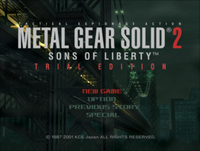
Title screen of Metal Gear Solid 2: Sons of Liberty Trial Edition.
Metal Gear Solid 2 was also intended to reference the novel City of Glass, a novel by Paul Auster published in 1985, most notably in the naming of its characters. Raiden's support team originally featured a field commander named Daniel Quinn (simply referred as the "Colonel" in-game); Maxine "Max" Work, an Asian woman who saves the game data and quotes Shakespeare; and William "Doc" Wilson, the creator of GW. All take their names from key characters in the book, and all three would have turned out to be AIs. None of these characters appear in the final version. Their roles were absorbed by other characters, namely the "Colonel Campbell" simulation, Rose, and Emma Emmerich. Peter Stillman, however, takes his name from another City of Glass character.[9]
A two player versus mode was also planned. However, it was dropped for unknown reasons.[9]
Metal Gear Solid 2 is the first Metal Gear game to contain a note at the beginning that states that the events of the story are fictional.[12] The note was presumably added in due to the events of September 11. This would later be repeated in Metal Gear Solid V: The Phantom Pain.
The consistent plot device throughout the game of all the characters either giving lies at least once or otherwise betraying and going to the other side of the conflict, according to Kojima, was based on the film L.A. Confidential.[13]
According to the localizer of the game, Agness Kaku, Konami and Kojima had been insistent that the localized script remain exactly the same as in Japan on a micro-level in a manner comparable to scientific journals and legal documents, meaning she could not remove anything even to keep the flow or reduce repetition.[14]
Footage
Just like in the previous game, real life footage was utilized for the game, namely for the New York City aspects. Some of the footage was done first-hand by the Konami development team, while others were supplied via IMAGICA Corp., FRONT LINE, Inc., and ABCNEWS VIDEOSOURCE.
September 11 terror attacks
Because the game finished development before 9/11 but wasn't due to be released yet, several aspects ended up significantly edited to avoid highlighting any similarities to the terror attacks. The most notable changes were a sequence depicting Arsenal Gear's displacement of the Statue of Liberty and crashing through half of Manhattan was removed, as was a short coda that was supposed to appear after the credits, consisting of a newscast showing the Statue of Liberty's new resting place on Ellis Island. At the point where Solidus Snake dies, Raiden was to have cut the rope on Federal Hall's flagpole, causing an American flag to fall over Solidus' body, though the development team removed all the American flags from the game.[15]
Additionally, several pieces of dialogue were cut, such as Liquid Ocelot claiming responsibility for Arsenal Gear ramming into Manhattan, as well as Vamp explicitly stating that Dead Cell's plan to use the purified hydrogen bomb to nuke Manhattan outright was independent of Solidus's goal of causing an EMP, and Raiden accusing President Johnson of working for the terrorists.
For most of the game's development, Raiden's name was written in katakana as ライデン or literally "Raiden." After 9/11, his name began to be written in kanji as 雷電. The name was altered because in Japanese, "Laden" is written as ラーディン.[16]
To a lesser extent, some artwork for the game was also altered as a result of 9/11. A notable example of this was one of the artworks that depicted Solid Snake posing near the Manhattan skyline. Originally, the skyline showed the World Trade Center, although this was edited out for the final versions of the artwork, including the version included in The Art of Metal Gear Solid 2. The original can be found on the October 2001 issue of Electronic Gaming Monthly, as it had been commissioned by Yoji Shinkawa specifically for the magazine.[17]
Music
Kojima's choice of composer for Metal Gear Solid 2 was highly publicized in the follow-up to the game's release. Kojima decided upon Harry Gregson-Williams, a Hollywood film composer from Hans Zimmer's studio, after watching The Replacement Killers with sound director Kazuki Muraoka. A mix CD containing 18 tracks of Gregson-Williams' work was sent to his office. Flattered by the research put into creating the CD (as some of the tracks were unreleased, and that what tracks he'd worked on for some films were undocumented), he joined the project soon after.
In order to bypass the language barrier and allow the score to be developed before the cutscenes were finalized, Gregson-Williams was sent short phrases or descriptions of the intended action. The resultant themes then shaped the action sequences in return. Gregson-Williams also arranged and re-orchestrated the original "Metal Gear Solid Main Theme" for use in the game's opening title sequence.
Norihiko Hibino, who had composed the music for Metal Gear: Ghost Babel, was responsible for all of the in-game music. He also worked on the majority of the game's cutscenes, re-orchestrating Gregson-Williams' "Main Theme" remix for use in several sequences.
As with Metal Gear Solid, the cutscene music includes orchestral and choir pieces, while the in-game soundtrack is scored with ambient electronic music. However, the score as a whole incorporates more electronic elements than its predecessor, in order to reflect the plot's thematic thrust of a machine-dominated society. Rika Muranaka again provided a vocal ending theme, a jazz track entitled "Can't Say Goodbye to Yesterday", sung by the late Carla White. The game's music was released via 4 CDs: Metal Gear Solid 2: Sons of Liberty Original Soundtrack, Metal Gear Solid 2: Sons of Liberty Soundtrack 2: The Other Side, Metal Gear Solid 2: Substance Limited Sorter (Black Edition) and Metal Gear Solid 2: Substance Ultimate Sorter (White Edition).
Symbolism
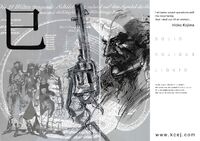
E3 2001 poster for Metal Gear Solid 2.
The background of an E3 2001 poster for Metal Gear Solid 2 features artwork from the 1822 Niklas Müller book Glauben, Wissen und Kunst der alten Hindus (Beliefs, Knowledge and Art of the Ancient Hindus).[18] The image depicts a turtle bearing the 21 worlds of Hindu mythology on its back, surrounded by the world serpent Shesha, one of the primal beings of creation. The image is also featured during the sequence in which the player must navigate Raiden through Arsenal Gear's interior, upon pausing the game with the Start button.
In addition, the poster's tagline notes the use of the snake to symbolize independence by the American founding fathers, and that "only the snake builds a new world." The various imagery can be said to represent the desires of Solidus, Liquid, and Solid Snake, to create a different world from that which is portrayed in the game's storyline. The artwork from Glauben, Wissen und the Kunst der alten Hindus could also be seen to represent either Arsenal Gear or the Big Shell, with the hexagonal designs of the former's hull and the latter's structure having a similar appearance to that of a turtle's shell. Arsenal itself is referred to as "tortoise-like" in Hideo Kojima's "Grand Game Plan."
Reception
| Reviews | |
|---|---|
| Publication | Score |
| Electronic Gaming Monthly | 9.5/10 |
| Game Informer | 10/10 |
| GamePro | 5/5 |
| GameSpot | 9.6/10 |
| GameSpy | 97/100 |
| GameZone | 9.8/10 |
| IGN | 9.7/10 |
| Official PlayStation Magazine | 5/5 |
| Compilations of multiple reviews | |
| Metacritic | 96 |
| GameRankings | 95.09% |
As a result of promising trailers and the huge commercial success of its predecessor Metal Gear Solid, there was a high level of anticipation and hype in the gaming community surrounding the release of Metal Gear Solid 2. Metal Gear Solid 2 received a large amount of critical and fan praise upon its release, maintaining an average of 95.09% on GameRankings,[2] making it the 4th highest rated PlayStation 2 game and the 27th highest rated game overall on the site.[19][20] The game scored a metascore of 96 on Metacritic.[1] The game also sold over 7 million copies worldwide and won multiple "Game of the Year" awards.
While critics praised the game's level of graphical detail, in particular the use of in-game graphics to render plot-driving cutscenes, the title's storyline was the source of mixed opinions. The storyline explores many philosophical and cyberpunk themes in great detail. Although some have praised Kojima's script, others considered the plot to be "incomprehensible" and overly heavy for an action game. Some also felt that the lengthy dialogue sections heavily disrupted the gameplay, and that the dialogue itself was overly disjointed and convoluted.
Fans were taken by surprise that they took the role of Raiden during the entirety of the Plant Chapter. Overall, the reception in North America and Europe was negative towards the introduction of Raiden. In Japan, it was neutral. Another dispute was the cutscenes which were considerably longer than the cutscenes in Metal Gear Solid, leading to complaints that Metal Gear Solid 2 was more like a movie with interactive sequences rather than a "Tactical Espionage" game.
Regardless of the mixed reviews of the game's drift from action based espionage and its very lengthy cutscenes and confusing nature, the game is still considered a staple in the stealth game genre, with over 7 million copies sold resulting in it being the best-selling game in the genre to date.
Metal Gear Solid 2: Substance
- Main article: Metal Gear Solid 2: Substance
Metal Gear Solid 2: Substance went multiplatform in Spring 2003, being released on the Xbox and Microsoft Windows. The new version included several new gameplay modes such as boss survival and the return of VR training and some minor graphical enhancements. The Windows version required an upgrade due to its high graphic content in which the user would need a DVD drive to play the game. Substance was ported to the PlayStation 2 several months later. It was released at the same time that the original version was added to Sony's Greatest Hits lineup.
Additions and changes in Substance include:
- Addition of a Boss Survival mode (was already included in the European and Japanese version of Metal Gear Solid 2).
- Addition of Skateboarding minigame (PlayStation 2 version only).
- Addition of 5 "Snake Tales", feature sized games.
- Addition of over 500 VR and Alternative missions.
- Addition of Casting Theater (was already included in the European and Japanese version of Metal Gear Solid 2).
- Alterations of names on dog tags.
- Alterations of thermal goggles graphics.
The Document of Metal Gear Solid 2
- Main article: The Document of Metal Gear Solid 2
In the month of September 2002, a making of interactive disc was released in Japan and North America titled The Document of Metal Gear Solid 2. The disc contains VR Missions, a built-in soundtrack, the mechanics and areas of the game, as well as the ability to look at player polygons. It isn't literally a "documentary" in a sense as it is more interactive. To a degree, it served its purpose to show the entire game of Metal Gear Solid 2.
It was eventually released in Europe in March 2003 at no cost. It was packaged with Metal Gear Solid 2: Substance to compensate for the former's delayed release.
Metal Gear Solid 2: Bande Dessinée
- Main article: Metal Gear Solid 2: Bande Dessinée
An interactive novel similar to Metal Gear Solid: Digital Graphic Novel based on the Metal Gear Solid 2 comic was released in Japan on June 12, 2008, titled Metal Gear Solid 2: Bande Dessinée. It was released on a DVD and features Japanese voice acting, unlike the Digital Graphic Novel.
Novelization
Raymond Benson
A novelization written by Raymond Benson was released on November 24, 2009. It covers the complete story and was released in Europe in February 2010. It also included material from the original script that was removed from the final version of Metal Gear Solid 2, due to 9/11, such as Raiden cutting down the American flag shortly after killing Solidus, and the Arsenal Gear crash sequence, the latter of which clarified that it was Liquid Ocelot who had directed the vessel to crash into Manhattan. It also added in a brief bit of dialogue in the ending between Raiden and Snake, where Raiden questioned how Snake could be certain that OIga's child is male. A Japanese version was also released.
Hitori Nojima
On August 4, 2015, it was announced that Hitori Nojima, the author of the novelization for Metal Gear Solid: Peace Walker, was working on three novelizations for the series, including one, titled Metal Gear Solid Substance II: NY, that focused on the events of Metal Gear Solid 2: Sons of Liberty. The novel was released on September 25, 26 days after the release of the first book, Metal Gear Solid Substance I: Shadow Moses. It features cover art by Yoji Shinkawa.[21]
Limited Editions
Like its predecessor, a limited edition Premium Package of the game was released. This package contains the game itself with a different cover art, a full color data book, a making of DVD and a limited edition Solid Snake figure by Yamoto. The Premium Package was only released in Japan.
A bundle pack was released on the same day as the game's European release. It contains a PlayStation 2 console and the game itself. The making of DVD was not included in the bundle.
Legacy
Metal Gear Solid 2 along with Metal Gear Solid were featured in the Smithsonian American Art Museum's "The Art of Video Games" exhibition, running from March 16 to September 30, 2012.[22]
Gallery
Packaging
Demos
Books
Videos
Merchandise
Paraphernalia
Illustrations
Trailers
See also
| Walkthrough Alert! |
|
We have a walkthrough for this game. Click here to view it |
- Solid Snake
- Raiden
- Metal Gear Solid 2 bosses
- Metal Gear Solid 2 secrets
- Voice actors
- Similarities between games
References
- ^ a b Metal Gear Solid 2: Sons of Liberty for PlayStation 2 Reviews - Metacritic
- ^ a b Metal Gear Solid 2: Sons of Liberty for PlayStation 2 - GameRankings
- ^ http://www.eurogamer.net/articles/2015-08-16-metal-gear-solid-2-the-first-postmodern-video-game
- ^ http://archives.insertcredit.com/features/dreaming2/index5.html
- ^ Metal Gear Solid 2 PS2 Game Guide
- ^ a b http://www.answers.com/topic/metal-gear-solid-2-sons-of-liberty
- ^ http://www.konami.jp/gs/game/mgs2/english/story/index_plant.html
- ^ http://www.konami.jp/gs/game/mgs2/english/story/index_tanker.html
- ^ a b c Metal Gear Solid 2 Grand Game Plan.
- ^ https://web.archive.org/web/20130328062143/http://www.gamespot.com/news/hideo-kojima-speaks-about-the-matrix-2448486
Kojima made a very interesting comment: "I have seen the movie four times (laughs). I like this type of work. What I was planning to do in my next project, they pretty much made into a motion picture. We were planning on certain things like characters running on walls and such, but they've beat me to it (laughs)." - ^ Metal Gear Saga Vol. 1 - YouTube
- ^ Metal Gear Solid 2: Sons of Liberty, Konami Computer Entertainment Japan (2001).
After the player selects the chapter they want to play, the message "This story is fictional. Any and all similarities to characters, groups, or other entities in real life are coincidental" will pop up. - ^ MGS2 Production Background Notes
- ^ http://www.eatchain.com/garbage/METALGEAR%3F%3F%3F/Metal%20Gear%20Solid%202%20Agness%20Kaku%20Intereview/Page%202/Hardcore%20Gaming%20101%20%20Agness%20Kaku%20Interview.htm
- ^ The Document of Metal Gear Solid 2.
- ^ Kotaku. What Osama Bin Laden And Metal Gears Solid Have In Common. Kotaku. Retrieved 2011-09-29.
- ^ https://twitter.com/Arc_Hound/status/1039187147960606720
- ^ [1]
- ^ 2 Reviews and News Articles - GameRankings
- ^ Browse and Search Games - GameRankings
- ^ http://www.metalgearinformer.com/?p=21057
- ^ The Art of Video Games


